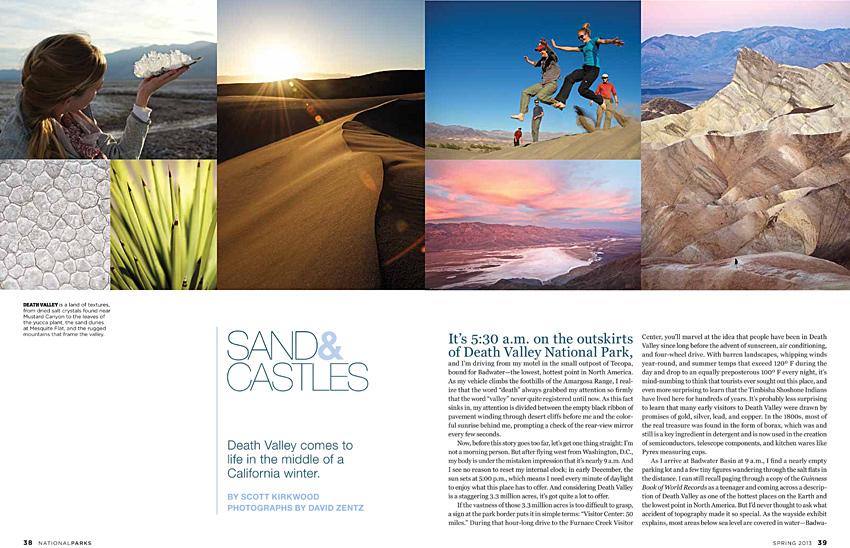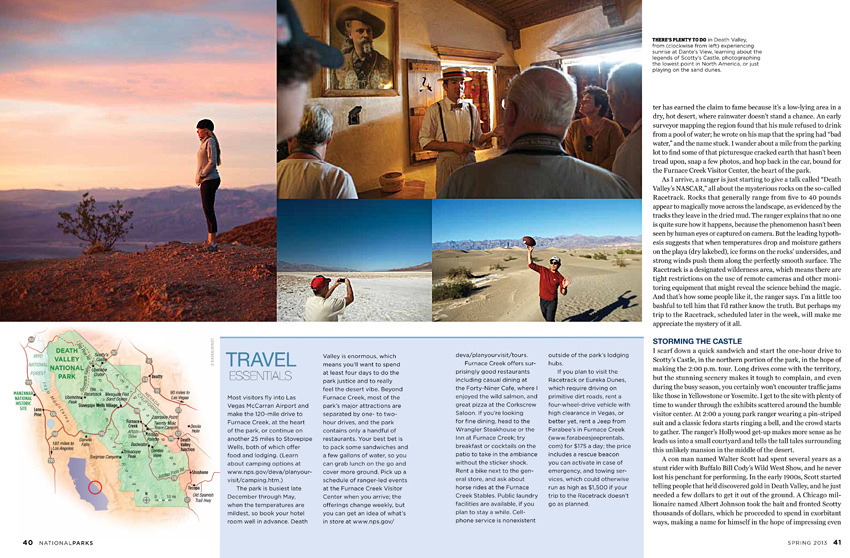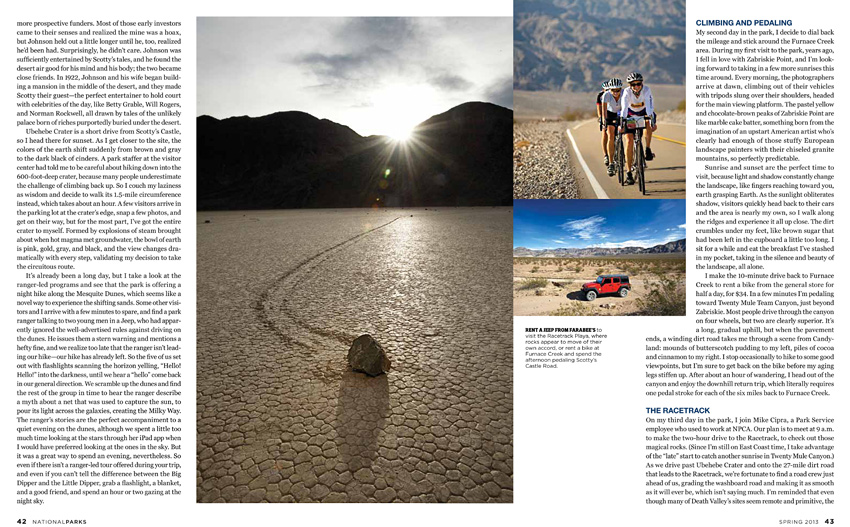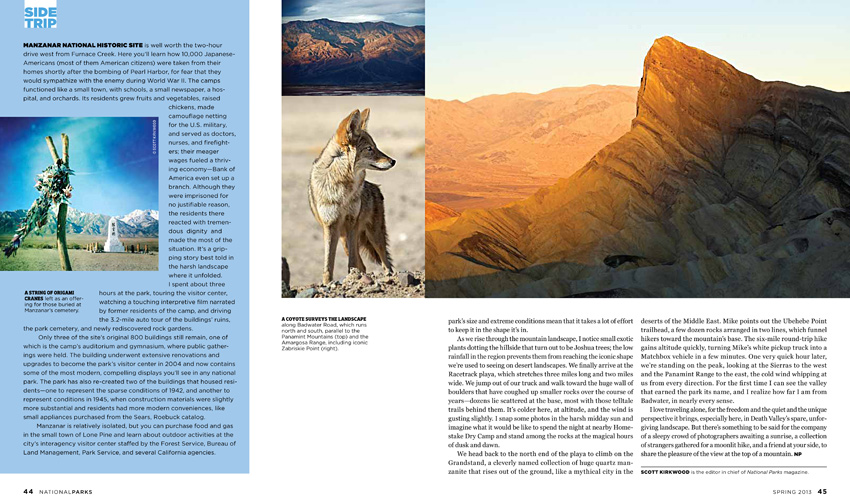Above is a spread from a recently published project I shot on Death Valley National Parks for National Parks Magazine, as well as a gallery showing a wider take of images from the project. The shoot took place over two fantastic trips at the end of 2012. The goal of the assignment was to create a mix of imagery showing not only the stunning landscapes the park has to offer, but also showing people actually using the park. Both turned out to be challenging tasks! I knew from the start that I was going to have to make two trips for this assignment, as I could only go for a few days at a time and knew the park was going to be impossible to cover in only 3 days. Death Valley NP is 3.3 million acres with some destinations taking several hours to reach by off-road vehicle. I committed to the idea that the first trip would primarily be exploratory as I tried to figure out what would be necessary to get the shots I wanted.
On my first trip the weather was gorgeous – topping out in the 80s when it was supposed to still be in the high-90s – but there wasn’t a cloud in the sky, leaving me mostly with a palate of tan earth and stark blue skies to work with outside of the hours surrounding sunrise and sunset. The scenery was still magnificent, and having a few stark photos would work, but I really wanted more color. Photographing people also proved to be challenging since despite there being a fair amount of them visiting the park, most were doing the same thing. That is, driving to their destination, hopping out of the car to take a photo with their point-and-shoot or cell phone, and then getting back into the car. You can make a photo from this – one made it into the spread in fact – but not a very interesting one. In addition there were very few kids in the park as school was still in session. I knew one of my best bets was to join a tour, so headed up to Scotty’s Castle to join one of the only tours available at that time of year. (Rather than go into detail here about the history of the seemingly out-of-place Scotty’s Castle, follow the link at the end of this entry to read the online article by Scott Kirkwood.) Finally, after a couple days of wandering around looking for anyone doing anything active in the park beyond taking photographs I came across a group of graduate students as they piled out of a van at the Mesquite Dunes, a popular attraction located in the center of the park. The group was at the park doing geological studies for a course at UT Austin and had arrived at the dunes to blow off some steam before heading back to Las Vegas to catch a flight home. To my delight, they were in a playful mood and started jumping from the low dunes, doing handstands and tossing a football around. They weren’t the rugged hiker photos I’d envisioned, but it yielded some fun photographs that I thought could be part of the final piece. That night I left the park happy with what I’d shot, but knowing I’d be back in a couple months. Fortunately, the magazine had given me a 3-month window to complete the assignment! A rare luxury.
In December I returned with my girlfriend Erinn to keep me company and possibly stand in as a model should I need a body in a far-off location. As a trained journalist only comfortable staging photos when shooting portraits and commercial work, this felt weird. But this was a travel piece, not straight journalism, and the editor was all for whatever made the best images. Mostly out of pride of being able to find photos where none seemingly exist, I made up my mind that I would shoot what I could find first and only resort to photographing her as a last resort. Two photos of her made it into the magazine. We arrived in the period between Thanksgiving and Christmas. Both holidays are apparently peak tourist season, but there’s a deep lull in between. So, even more than my last trip, we had the park to ourselves. The weather, however, was a bit more cooperative. There were clouds! This added some much-needed drama and color to my shots, particularly one early morning, where from atop Dante’s View, overlooking the entire Death Valley, the clouds turned into magnificent tufts of pastel-colored cotton candy. On this trip we also rented a Jeep from Farabee’s, located in the center of the park by the Furnace Creek Inn, in order to make the 27-mile, bone rattling, off-road trek to the famous Racetrack, known for it’s mysterious sliding rocks. This is probably the most amazing spot in the park and well worth the Jeep rental and the three-hour trek! The Racetrack is a dry lakebed surrounded by mountains that has a perfectly flat surface of lightly colored, cracked mud. The cracks form nearly identically-sized shapes across the entire 3-mile long surface. We arrived at sunrise – which required waking up at 3:45 a.m. – and were the only ones there for the first two hours of the day. Only here and in White Sands, New Mexico, have I ever felt like I was on another planet. In the far right corner of the lakebed is where you’ll find the rocks, slowly creeping away from the crumbling hillside they have fallen from, leaving long trails behind them in the dried mud. The biggest shame was coming across a number of trails in the mud that had no rocks at the end of them. Some wonderful people apparently think these rocks, which take many years to move across the mud, make great souvenirs. It’s apparently common enough that the park service has adhered metal plates to some of the rocks reminding people to leave them be. Fortunately, there are a lot of rocks still in place for those who care to make the trek.
In the end I was satisfied with what I’d been able to shoot over the course of both trips and am happy to finally see it in print. There were still missed opportunities though, so I’m actually heading back to the park again next week to keep shooting. I’m hoping to see some spring blooms and just to enjoy the park one more time before it gets too hot! I’ll be sure to post some favorites after my return.




I just love looking at your photography, David.